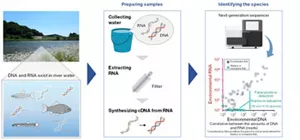Environmental RNA-based Ecological Impact Assessment
Environmental Science
Human activities are closely linked to our environment, and excessive consumption activities affect biodiversity. Kao is attempting to reduce the effects on biodiversity to the minimum level for achieving a society that can coexist with nature.
Ecological surveys to investigate the number and types of organisms are indispensable for planning guidelines for biodiversity conservation or policies for solving environmental problems. A convenient technique for ecological surveys that is entering the spotlight is analyzing DNA derived from organisms remaining in environments such as rivers and soils (environmental DNA). However, the environmental DNA is hard to decompose and remains for a long time, which leads to the problem of false positives: a survey result containing organisms that do not actually live there.
Kao is focusing on RNA, which is generally known to degrade more easily than DNA, and working to establish fundamental technology for an environmental RNA-based, new ecological survey method. The environmental RNA derived from organisms no longer found in a particular place will promptly disintegrate and almost none if any will be detected. Previous survey results suggest that this provides accurate ecological survey results. For example, this will reduce false positives of marine fish in a survey of river fish in a freshwater environment.
We will use this technology to help solve broad environmental problems such as biodiversity conservation and environmental assessments. Kao will apply the knowledge from this technology to deliver scientific knowledge-based safe and secure products to customers around the world and contribute to environmental, social, and governance (ESG) activities that take ecosystems into account.

Published Articles
K. Miyata et al. Ecol. Indic. 128, 107796, 2021.
K. Miyata et al. Sci Rep. 12, 19828, 2022.
Y. Inoue et al. ACS EST Water 3, 756-764, 2023.
- Home
- Innovation
- Research & Development
- Fundamental Research
- Safety Science
- Environmental RNA-based Ecological Impact Assessment
- Home
- Innovation
- Research & Development
- Fundamental Research
- Safety Science
- Environmental RNA-based Ecological Impact Assessment
